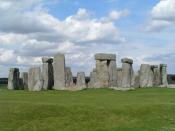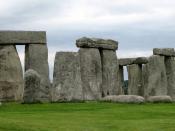A mysterious phenomenon project
Stonehenge
Stonehenge- a mystical place
A gigantic megalithic monument on the Salisbury Plain, in Wiltshire, England.
Stonehenge was build during three phases:
Phase one began in approximately 3,100 BC. It consisted of a small circle surrounded by a few dozens of wooden columns, in a diameter of about 10 m'. It was built by local tribes. The columns didn't survive until today.
Phase two began around 2,100 BC (the bronze era). It occured when tribes from Europe invaded Britain. The tribes had metal processing skills and they added two rings of 80 "bluestones", that came from the Presely Mountains, in southwest Wales, 200 kilometers away.
Each "bluestone" weights at least a few tons.
Phase three lasted for 900 years, from 2,000 BC until 1,100 BC. During this period, the "bluestones" were removed, and 30 huge stones ("the sarsen-stones"), which weighted 50 tons each, were placed instead, in an outer circle.
All these stones were linked by stone lintels. The ring is 5.5 m' high, and its diameter is 30.5 m'. An altar stone, that weights 6 tons, was placed in the middle. The stones were brought from Marlborough Dawns, 30 kilometers away from the site. The bluestones were re-erected in the center of Stonehenge, in an oval, horseshoe like shape.
At approximately 1550 BC, the bluestones were rearranged in a smaller circle, and the site was abandoned.
Many things show that Stonehenge is a mysterious place (study cases):
- How did the stones get to Stonehenge?
Each one of the 80 bluestones, which were used in phase two, weighted 15 tons. They were brought to Stonehenge from a distance of 200 kilometers. The sarsen-stones (used in phase three) that weighed up to 50 tons, traveled 30 kilometers. For years, the archeologists are...


